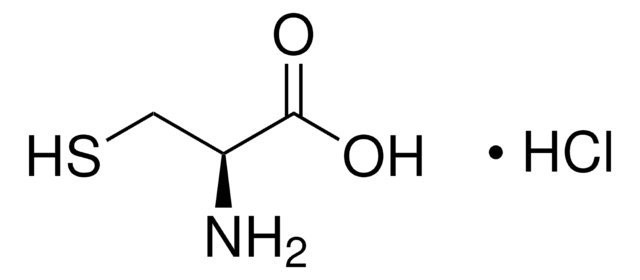1.02839
L-Cysteine hydrochloride monohydrate
for biochemistry
Synonym(s):
Cys, L-Cysteinium Chloride Monohydrate, L-Cysteine Hydrochloride, Monohydrate
About This Item
Recommended Products
vapor pressure
<0.1 hPa ( 20 °C)
Quality Level
Assay
98.5-101.0% dry basis (alkalimetric)
form
crystalline powder
pH
0.8-1.2 (20 °C, 100 g/L in H2O)
mp
168-170 °C
solubility
650 g/L
density
1.54 g/cm3
bulk density
780 kg/m3
anion traces
sulfate (SO42-): ≤300 ppm
cation traces
Fe: ≤20 ppm
heavy metals (as Pb): ≤10 ppm
storage temp.
2-30°C
SMILES string
O.Cl.N[C@@H](CS)C(O)=O
InChI
1S/C3H7NO2S.ClH.H2O/c4-2(1-7)3(5)6;;/h2,7H,1,4H2,(H,5,6);1H;1H2/t2-;;/m0../s1
InChI key
QIJRTFXNRTXDIP-JIZZDEOASA-N
Looking for similar products? Visit Product Comparison Guide
Related Categories
Application
- Smartphone-based Ellman′s colourimetric methods for the analysis of d-penicillamine formulation and thiolated polymer: Demonstrates the application of L-Cysteine hydrochloride monohydrate in developing colorimetric assays for pharmaceutical analysis, enhancing the accessibility and cost-effectiveness of drug quality control (Phadungcharoen et al., 2019).
- The effects of the thiolation with thioglycolic acid and l-cysteine on the mucoadhesion properties of the starch-graft-poly(acrylic acid): Focuses on the modification of polymers with L-Cysteine hydrochloride monohydrate to improve their mucoadhesive properties, which is critical for developing more effective drug delivery systems (Gök et al., 2017).
- On-line pre-reduction of pentavalent arsenicals by thioglycolic acid for speciation analysis by selective hydride generation-cryotrapping-atomic absorption spectrometry: Utilizes L-Cysteine hydrochloride monohydrate in analytical chemistry techniques to improve the detection and measurement of toxic elements in environmental samples, crucial for monitoring and ensuring public health (Musil et al., 2008).
Biochem/physiol Actions
Analysis Note
Identity (IR-spectrum): passes test
Identity (Chloride): passes test
Appearance: white or almost white, crystalline powder or colorless crystals
Appearance of solution (25 g/l, water): clear and not more intense in color than reference solution BY6
Spec. rotation (α 20/D, 80 g/l, hydrochloric acid 250 g/l, calc. on dried substance): +5.5 to +7.0
Spec. rotation (α 25/D, 80 g/l, hydrochloric acid 6 mol/l, calc. on dried substance): +5.7 to +6.8
Sulfate (SO₄): ≤ 300 ppm
Heavy metals (as Pb): ≤ 10 ppm
Fe (Iron): ≤ 20 ppm
Related Compounds, total (TLC): ≤ 0.5 %
Ninhydrin-positive substances (LC)(impurity A (570 nm)): ≤ 0.5 %
Ninhydrin-positive substances (LC)(any ninhydrin-positive impurity): ≤ 0.2 %
Ninhydrin-positive substances (LC) (ammonium (570 nm)): ≤ 0.02 %
Ninhydrin-positive substances (LC)(total impurities): ≤ 1.0 %
Residual solvents (ICH Q3C): excluded by manufacturing process
Sulfated ash (600 °C): ≤ 0.1 %
Loss on drying (Vacuum < 0.7 kPa, P₂O₅, 24 h): 8.0 - 12.0 %
Bacterial endotoxins: ≤ 6.0 I.U./g
Storage Class Code
11 - Combustible Solids
WGK
WGK 1
Flash Point(F)
Not applicable
Flash Point(C)
Not applicable
Certificates of Analysis (COA)
Search for Certificates of Analysis (COA) by entering the products Lot/Batch Number. Lot and Batch Numbers can be found on a product’s label following the words ‘Lot’ or ‘Batch’.
Already Own This Product?
Find documentation for the products that you have recently purchased in the Document Library.
Customers Also Viewed
Our team of scientists has experience in all areas of research including Life Science, Material Science, Chemical Synthesis, Chromatography, Analytical and many others.
Contact Technical Service


